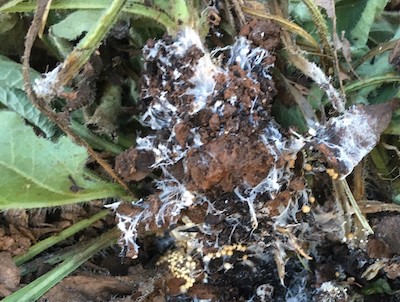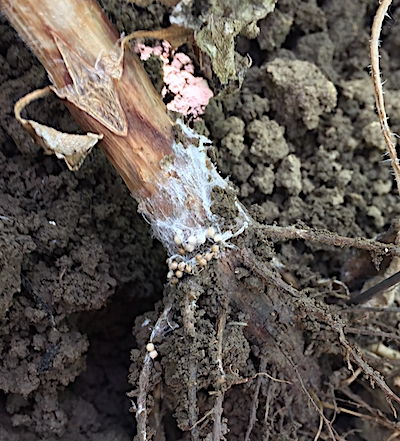Southern Blight — Here It Comes
By Carmine Carosella, Fairfax Master Gardener

Southern Blight mycelium at roots
It was a typical July, hot and humid here in Fairfax County, and my vegetable garden was thriving, or so I thought. Some of the pepper plants, already more than 2 feet tall, looked like they needed some water; the leaves were wilting. But why? The ground looked moist. Within days, many of my pepper plants had completely wilted and were dead. It was the dreaded southern blight.
Once a disease of the southern states, southern blight is now appearing in the Mid-Atlantic. It is a soil-borne fungal pathogen, Sclerotium rolfsii, that attacks most all herbaceous perennials, vegetables, annuals and herbs. Plants will grow normally until the fungus develops, between 80 and 90 degrees F in water-saturated soils. The fungus attacks plants initially on the stem at the soil line. The roots of the plant are fine, but the decay of the tissue at the soil surface destroys the vascular system of the plant, and rapid death occurs.

Close-up of green and gold by southern blight. Note presence of mycelium and small sclerotia spheres
Professional horticulturalist, David Yost of the Merrifield Garden Center in Fairfax County, shared some of his personal southern blight woes with me. The pictures show his shade garden, featuring the perennial, Green and Gold, Chrysogonum virginianum, before and after an attack by southern blight. In the after picture, you can clearly see the white mycelium of the fungus, along with small, white spheres that are called sclerotia. These sclerotia eventually turn tan and harden. They stay in the soil for up to five years and are the source of future fungal infections. David says that he has had much difficulty finding plants that will survive the blight in that particular part of his garden, but he continues to experiment.
So, what’s a gardener to do? Big-time operators might plant various grains, including corn that are not susceptible to the blight, or leave infected fields empty for some years. There are some approaches for the home gardener, however, listed below.
Sanitation
Remove infected plants and some soil near the base of the plants. Do not compost the plants, since the sclerotia are hard to kill.
Burying
Sclerotium rolfsii needs oxygen to grow; the fungus only develops in the first few inches of the soil. Turning over the soil with a spade could remove the fungus. Covering the soil with uncontaminated mulch would also help.
Solarization
Sclerotia are killed in four to six hours at 122 degrees F. Thus, covering moist soil with clear polyethylene plastic in the summer sun can decontaminate the soil.

Mycelia and Sclerotia
Raising the soil pH: Sclerotia germinate in the pH range of 2 to 5 but is inhibited at pH 7 and above.
Back to my peppers. The southern blight occurred in a small area of my vegetable garden. Peppers grew fine about 30 feet away. This year, I will first turn the soil over deeply in that contaminated area. Then I will cover the area with clear plastic.
I plan to plant sweet potatoes in a large pot and let them spread over the contaminated area. In the remaining garden, where I plant peppers and tomatoes, I plan to cover the soil around the base of each plant with wood ash to inhibit southern blight infection via the high pH. Will these approaches work? Who knows, but for gardeners, hope always springs eternal.
References
• Integrated Management of Southern Blight in Vegetable Production, Chenzhao Xie and Gary Vallad,
University of Florida Extension
• Southern Blight — a disease becoming more prevalent in Missouri, Zelalem Mersha, University of
Missouri Integrated Pest Management
• Southern Blight Disease on Flowers, University of Maryland Extension